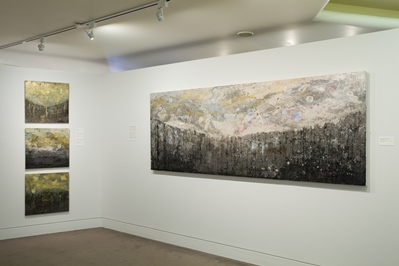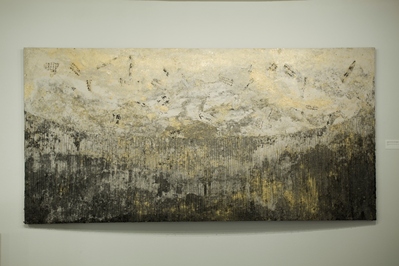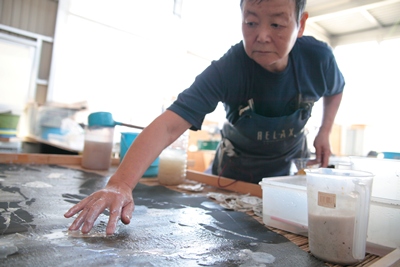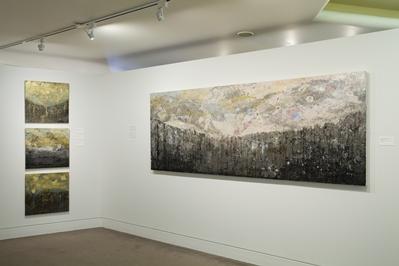On Thursday night, paper artist Ibe Kyoko and curator Hollis Goodall will discuss the current exhibition Washi Tales: The Paper Art of Ibe Kyoko, followed by a special, not-to-be-missed performance based on Ibe’s work, featuring actors and an ensemble of musicians playing traditional Japanese instruments. Below, Goodall provides insight into Ibe’s work. More information on Thursday’s event can be found here.
A piece of the world was wiped away on March 11 of this year. In the northeastern area of Honshu, the main island of Japan, what is left to us after earthquake and tsunami is bits of lives that were. For the last ten years, the washi (Japanese paper) artist Ibe Kyoko has incorporated bits of former lives in the form of torn pieces of letters and documents into her works of art. Following the earthquake and tsunami, Ibe-san’s thoughts turned to her family members and ancestors who lived in Fukushima, and to her aging mother who had come from that region. Reaching into her family’s home altar (butsudan), Ibe-san pulled out family documents dating back over 100 years. From her personal files came letters brushed on beautiful paper from her parents and close relatives, and letters in English from friends. These became the material and stimulus for her present series, called Once Upon a Time, of which several works are on display in the Pavilion for Japanese Art. Ibe-san made the first work of the series for her mother’s home. At LACMA, the largest of the pieces from the series in the gallery has the characters for “mother” and “father” displayed prominently amid the parts of documents and letters now bound into the surface of the new paper art work.

Ibe Kyoko, Four untitled works from the series “Once Upon a Time,” 2011, recycled ganpi paper fiber, old documents, mica, indigo and sumi, collection of the artist
It was a decade ago that Ibe-san went to a used book store and brought home a handwritten census from a town no longer to be found on a map. She became inspired to bring the recorded fragments of information about these forgotten souls into her works of art. How that town disappeared is a mystery, perhaps caused more by economics than natural disaster. That so many people and their town had virtually evaporated from history but for this document that she chanced upon struck her deeply. Their lives began to re-appear a small piece at a time in the surfaces of her artworks. The series called Hogosho (writings on scratch paper) recalls her early concepts about working with recycled texts.

Ibe Kyoko, Untitled, from the series “Hogosho,” 2008, recycled ganpi paper fiber, old documents, mica and sumi, collection of the artist
Sitting in a screen mounter’s studio one day, she noticed that scratch paper reused by the mounter to provide backing for the painting on a screen would begin to peek out from tears in the painted surface or backing paper as the screen aged. She became fascinated with the screen mounting itself as being a time capsule. Old records, inventories, cash receipts, or memos socked into the interior of a screen for support, as old Japanese paper is still strong and useful, represented life at the moment that the screen was being mounted. Japanese paper, most commonly sourced from the inner bark of the paper mulberry (kozo), though in Ibe-san’s case taken from antique paper originally made from the bark of the ganpi bush (a plant of the Daphne family), is both durable because of its long fibers and valuable as the plants from which they come grow relatively slowly. As such, paper has always been valued and reused. Though she refers to her works as “recycled” paper, the lives denoted upon them are in a way resurrected.

Ibe Kyoko in her Kyoto studio placing document bits to be mixed with glue and ganpi paper fiber on a paper-making screen. Photo provided by Ibe Kyoko
The power of nature is so often beyond what people can control. Harnessing that power is part of Ibe-san’s expression. Having laid bits of documents, chips of mica, flakes of gold or silver, recycled indigo paper, and other precious materials onto the paper screen, she then begins to apply paper pulp behind that surface. As she adds layers and layers of various colored pulps of recycled paper behind those, some dense with calligraphy so they take on the color of gray sumi, others pink from the vermillion of seals used to sign a document, colors merge onto the surface and fibers bind with the elements already applied. Layer upon layer of pulp is added with great quantities of water, and Ibe-san relinquishes control, allowing the water to rearrange paper fibers and draw pulp into various patterns. The power of water and the strength of plants inspire this work, while the people whose writings are merged into her paper she feels to be living again through traces of their words.



